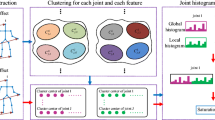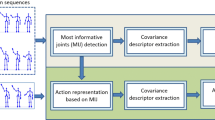Abstract
Human action recognition is still an uncertain computer vision problem, which could be solved by a robust action descriptor. As a solution, we proposed an action recognition descriptor using only the 3D skeleton joint’s points to perform this unsettle task. Joint’s point interrelationships and frame-frame interrelationships are presented, which is a solution backbone to achieve human action recognition. Here, many joints are related to each other, and frames depend on different frames while performing any action sequence. Joints point spatial information calculates using angle, joint’s sine relation, and distance features, whereas joints point temporal information estimates from frame-frame relations. Experiments are performed over four publicly available databases, i.e., MSR Daily Activity 3D Dataset, UTD Multimodal Human Action Dataset, KARD- Kinect Activity Recognition Dataset, and SBU Kinect Interaction Dataset, and proved that proposed descriptor outperforms as a comparison to state-of-the-art approaches on entire four datasets. Angle, Sine relation, and Distance features are extracted using interrelationships of joints and frames (ASD-R). It is all achieved due to accurately detecting spatial and temporal information of the Joint’s points. Moreover, the Support Vector Machine classifier supports the proposed descriptor to identify the right classification precisely.













Similar content being viewed by others
Explore related subjects
Discover the latest articles, news and stories from top researchers in related subjects.References
Tran, Tuan D, Yamazoe H, Lee J-H (2020) Multi-scale affined-HOF and dimension selection for view-unconstrained action recognition. Applied Intelligence:1–19
Gu Y, Ye X, Sheng W, Yongsheng O, Li Y (2020) Multiple stream deep learning model for human action recognition. Image Vis Comput 93:103818
Majd M, Safabakhsh R (2019) A motion-aware ConvLSTM network for action recognition. Appl Intell 49(7):2515–2521
Liu M, Yuan J (2018) Recognizing human actions as the evolution of pose estimation maps. In Proceedings of the IEEE Conference on Computer Vision and Pattern Recognition:1159–1168
Kerboua A, Batouche M (2019) 3D skeleton action recognition for security improvement. International Journal of Intelligent Systems and Applications 11(3):42–52
Ashwini K, Amutha R (2020) Skeletal data based activity recognition system. In 2020 International Conference on Communication and Signal Processing (ICCSP), pp. 444–447. IEEE
Liu J, Wang G, Duan L-Y, Abdiyeva K, Kot AC (2017) Skeleton-based human action recognition with global context-aware attention LSTM networks. IEEE Trans Image Process 27(4):1586–1599
Qin Y, Mo L, Li C, Luo J (2020) Skeleton-based action recognition by part-aware graph convolutional networks. Vis Comput 36(3):621–631
Gaglio S, Re GL, Morana M (2014) Human activity recognition process using 3-D posture data. IEEE Transactions on Human-Machine Systems 45(5):586–597
Cippitelli E, Gasparrini S, Gambi E, Spinsante S (2016) A human activity recognition system using skeleton data from rgbd sensors. Computational intelligence and neuroscience 2016:21
Papadopoulos, K, Antunes M, Aouada D, Ottersten B (2017) Enhanced trajectory-based action recognition using human pose. In 2017 IEEE International Conference on Image Processing (ICIP), pp. 1807-1811. IEEE
Zhu W, Lan C, Xing J, Zeng W, Li Y, Shen L, Xie X (2016) Co-occurrence feature learning for skeleton based action recognition using regularized deep LSTM networks. In Thirtieth AAAI Conference on Artificial Intelligence
Song S, Lan C, Xing J, Zeng W, Liu J (2017) An end-to-end spatio-temporal attention model for human action recognition from skeleton data. In Thirty-first AAAI conference on artificial intelligence
Liu J, Wang G, Hu P, Duan L-Y, Kot AC (2017) Global context-aware attention LSTM networks for 3D action recognition. In Proceedings of the IEEE Conference on Computer Vision and Pattern Recognition:1647–1656
Liu J, Shahroudy A, Xu D, Wang G (2016) Spatio-temporal lstm with trust gates for 3d human action recognition. In European conference on computer vision, pp. 816–833. Springer, Cham
Ke Q, An S, Bennamoun M, Sohel F, Boussaid F (2017) Skeletonnet: mining deep part features for 3-d action recognition. IEEE signal processing letters 24(6):731–735
Ke Q, Bennamoun M, An S, Sohel F, Boussaid F (2017) A new representation of skeleton sequences for 3d action recognition. In Proceedings of the IEEE conference on computer vision and pattern recognition:3288–3297
Escobedo E, Camara G (2016) A new approach for dynamic gesture recognition using skeleton trajectory representation and histograms of cumulative magnitudes. In 2016 29th SIBGRAPI conference on graphics, patterns and images (SIBGRAPI), pp. 209–216. IEEE
Evangelidis G, Singh G, Horaud R (2014) Skeletal quads: Human action recognition using joint quadruples. In 2014 22nd International Conference on Pattern Recognition, pp. 4513–4518. IEEE
Hussein ME, Torki M, Gowayyed MA, El-Saban M (2013) Human action recognition using a temporal hierarchy of covariance descriptors on 3d joint locations. In Twenty-Third International Joint Conference on Artificial Intelligence
Yao L, Yang W, Huang W (2020) A data augmentation method for human action recognition using dense joint motion images. Appl Soft Comput 106713
Du Y, Wang W, Liang W (2015) Hierarchical recurrent neural network for skeleton based action recognition. In Proceedings of the IEEE conference on computer vision and pattern recognition:1110–1118
Li C, Hou Y, Wang P, Li W (2017) Joint distance maps based action recognition with convolutional neural networks. IEEE Signal Processing Letters 24(5):624–628
Wang P, Li Z, Hou Y, Li W (2016) Action recognition based on joint trajectory maps using convolutional neural networks. In Proceedings of the 24th ACM international conference on Multimedia:102–106. ACM
Chikhaoui Band, Gouineau F (2017) Towards automatic feature extraction for activity recognition from wearable sensors: a deep learning approach. In 2017 IEEE International Conference on Data Mining Workshops (ICDMW), pp. 693–702. IEEE
Hadfield S, Lebeda K, Bowden R (2017) Hollywood 3d: what are the best 3d features for action recognition? Int J Comput Vis 121(1):95–110
Wang P, Wang S, Gao Z, Hou Y, Li W (2017) Structured images for RGB-D action recognition. In Proceedings of the IEEE International Conference on Computer Vision:1005–1014
Chaaraoui A, Padilla-Lopez J, Flórez-Revuelta F (2013) Fusion of skeletal and silhouette-based features for human action recognition with RGB-D devices. In Proceedings of the IEEE international conference on computer vision workshops:91–97
Chen C, Jafari R, Kehtarnavaz N (2015) Action recognition from depth sequences using depth motion maps-based local binary patterns. In 2015 IEEE Winter Conference on Applications of Computer Vision, pp. 1092–1099. IEEE
Xu H, Chen E, Liang C, Lin Q, Guan L (2015) Spatio-temporal pyramid model based on depth maps for action recognition. In 2015 IEEE 17th International Workshop on Multimedia Signal Processing (MMSP), pp. 1–6. IEEE
Ijjina EP, Chalavadi KM (2017) Human action recognition in RGB-D videos using motion sequence information and deep learning. Pattern Recogn 72:504–516
Li W, Zhang Z, Liu Z (2010) Action recognition based on a bag of 3d points. In 2010 IEEE Computer Society Conference on Computer Vision and Pattern Recognition-Workshops, pp. 9–14. IEEE
Chen C, Jafari R, Kehtarnavaz N (2015) Utd-mhad: A multimodal dataset for human action recognition utilizing a depth camera and a wearable inertial sensor. In 2015 IEEE International conference on image processing (ICIP), pp. 168–172. IEEE
Yun K, Honorio J, Chattopadhyay D, Berg TL, Samaras D (2012) Two-person interaction detection using body-pose features and multiple instance learning." In 2012 IEEE Computer Society Conference on Computer Vision and Pattern Recognition Workshops, pp. 28–35. IEEE
Hearst MA, Dumais ST, Osuna E, Platt J, Scholkopf B (1998) Support vector machines. IEEE Intelligent Systems and their applications 13(4):18–28
Hu Z, Zhang H, Yang Y, Yang C (2019) An improved method for interest point detection in human activity video. In Journal of Physics: Conference Series 1237(2):022089. IOP Publishing
Gori I, Aggarwal JK, Matthies L, Ryoo MS (2016) Multitype activity recognition in robot-centric scenarios. IEEE Robotics and Automation Letters 1(1):593–600
Tasnim N, Islam M, Baek J-H (2020) Deep learning-based action recognition using 3D skeleton joints information. Inventions 5(3):49
Wang H, Liang W (2017) Modeling temporal dynamics and spatial configurations of actions using two-stream recurrent neural networks. In Proceedings of the IEEE Conference on Computer Vision and Pattern Recognition:499–508
Theodorakopoulos I, Kastaniotis D, Economou G, Fotopoulos S (2014) Pose-based human action recognition via sparse representation in dissimilarity space. J Vis Commun Image Represent 25(1):12–23
Jin K, Jiang M, Kong J, Huo H, Wang X (2017) Action recognition using vague division DMMs. The Journal of Engineering 2017(4):77–84
Zhu, Jiagang, Wei Zou, Liang Xu, Yiming Hu, Zheng Zhu, Manyu Chang, Junjie Huang, Guan Huang, and Dalong Du. Action machine: rethinking action recognition in trimmed videos. arXiv preprint arXiv:1812.05770 (2018)
Zeng S, Lu G, Yan P (2018) Enhancing human action recognition via structural average curves analysis. SIViP 12(8):1551–1558
Dhiman C, Vishwakarma DK (2017) High dimensional abnormal human activity recognition using histogram oriented gradients and zernike moments. In 2017 IEEE International Conference on Computational Intelligence and Computing Research (ICCIC), pp. 1–4. IEEE
Jalal A, Khalid N, Kim K (2020) Automatic recognition of human interaction via hybrid descriptors and maximum entropy Markov model using depth sensors. Entropy 22(8):817
Islam, M. Shujah, Mansoor Iqbal, Nuzhat Naqvi, Khush Bakhat, M. Mattah Islam, Shamsa Kanwal, and Zhongfu Ye. "CAD: Concatenated action descriptor for one and two person (s), using Silhouette and Silhouette's skeleton. IET Image Processing (2019)
Escalera S, Pujol O, Radeva P (2009) Separability of ternary codes for sparse designs of error-correcting output codes. Pattern Recog Lett 30(3):285–297
Escalera S, Pujol O, Radeva P (2010) On the decoding process in ternary error-correcting output codes. IEEE Trans Pattern Anal Mach Intell 32(7):120–134
Allwein E, Schapire R, Singer Y (2000) Reducing multiclass to binary: a unifying approach for margin classifiers. Journal of Machine Learning Research 1:113–141
Fürnkranz J (2002) Round Robin classification. J Mach Learn Res 2:721–747
Acknowledgments
This work is supported by the Fundamental Research Funds for the Central Universities (Grant no. WK2350000002).
Author information
Authors and Affiliations
Corresponding author
Additional information
Publisher’s note
Springer Nature remains neutral with regard to jurisdictional claims in published maps and institutional affiliations.
Rights and permissions
About this article
Cite this article
Islam, M.S., Bakhat, K., Khan, R. et al. Action recognition using interrelationships of 3D joints and frames based on angle sine relation and distance features using interrelationships. Appl Intell 51, 6001–6013 (2021). https://doi.org/10.1007/s10489-020-02176-3
Accepted:
Published:
Issue Date:
DOI: https://doi.org/10.1007/s10489-020-02176-3




